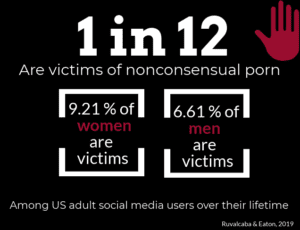One out of every 12 respondents in a nationwide survey say they have been victims of nonconsensual pornography.
The findings were released today in a new study by FIU Ph.D. candidate Yanet Ruvalcaba and Psychology Assistant Professor Asia Eaton. Women and sexual minorities reported higher rates of victimization — meaning they appear in a sexually explicit image or video that was shared without their consent. Most cases reported in the survey occurred during the victim’s emerging adult years — late teens into their early 20s. Typically, the person sharing the sexually explicit material without permission was someone known to the victims and more often than not, was a current or former intimate partner.
 The researchers also found that the respondents who say they were victims of nonconsensual porn experienced physical and mental health issues including depression, anxiety and even post traumatic stress disorder. As the prevalence of sexting continues to increase among teens and young adults, the potential for nonconsensual porn victimization is likely growing, Eaton said.
The researchers also found that the respondents who say they were victims of nonconsensual porn experienced physical and mental health issues including depression, anxiety and even post traumatic stress disorder. As the prevalence of sexting continues to increase among teens and young adults, the potential for nonconsensual porn victimization is likely growing, Eaton said.
“Our findings help to situate nonconsensual porn in the broader literature on gender-based sexual violence, and provide quantitative evidence for what victims have been saying all along — this is abuse, and it can negatively affect every aspect of your functioning,” Eaton said.
But this study is just a first step, she said, and more research is needed to better determine the actual harms inflicted upon survivors of nonconsensual porn as well as the motives and characteristics of perpetrators. In the same survey, one out of every 20 respondents admitted to being someone who actually shared a sexually explicit image or video without permission. Sixty-seven percent of all reporting perpetrators were men. More than 3,000 adults, representing all 50 states, responded to the online survey.
In the last decade, there has been a dramatic increase in the reports of “revenge porn,” but the researchers fear that label actually leads to lower rates of reporting of nonconsensual porn. For one, the term “revenge” implies the intent to harm and “revenge” also suggests the victim first did something to instigate the act. Eaton points out nonconsensual porn is more encompassing of the actual crimes being committed. Laws protecting victims vary from state to state, however, and the researchers argue some do not go far enough in protecting potential victims. In Florida, state law on sexual cyberharassment specifies that nonconsensual pornography is only criminal when posted to an internet website and when it is “willfully and maliciously” disseminated for the purpose of “causing substantial emotional distress to the depicted person.” This law does not protect victims whose images were disseminated via email or text, or those who cannot prove their perpetrator had malicious intent.
“Passing a national law criminalizing nonconsensual porn is an important part of the picture, but we also need a cultural shift in the narratives around this form of violence. Professionals and the general public need to stop blaming victims for the spread of their intimate images,” Eaton said.
“People share intimate things in their close relationships — that’s the very definition of a close relationship. We trust our partners with our bank accounts, our children, our deepest secrets, and our sexual lives. When this trust is violated the only person to blame is the perpetrator. Trying to stop this form of gender-based violence by asking folks not to send pictures to begin with is both sexist and futile.”
The research was conducted in partnership with Cyber Civil Rights Initiative, which also offers resources to help victims of consensual pornography.





